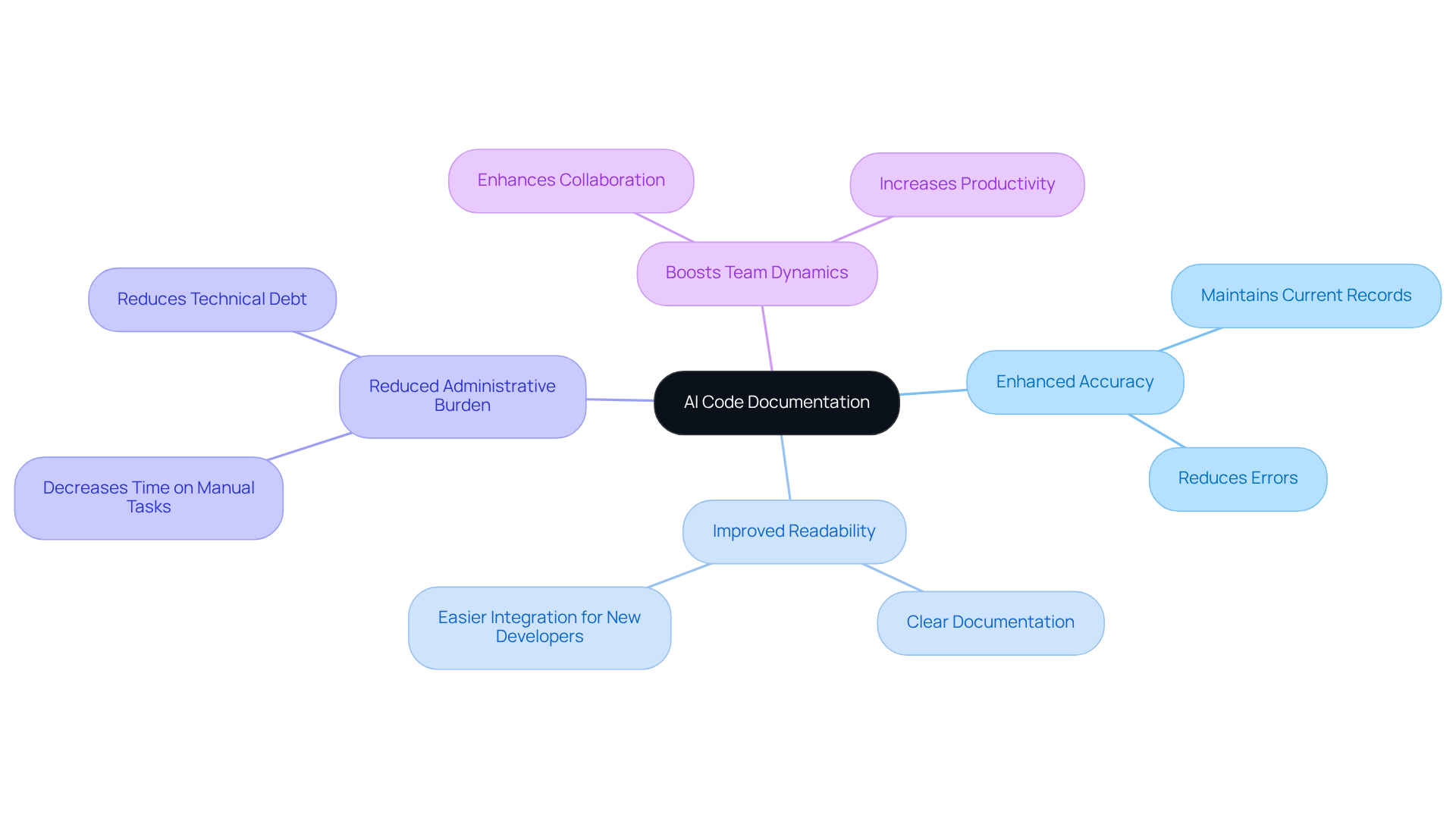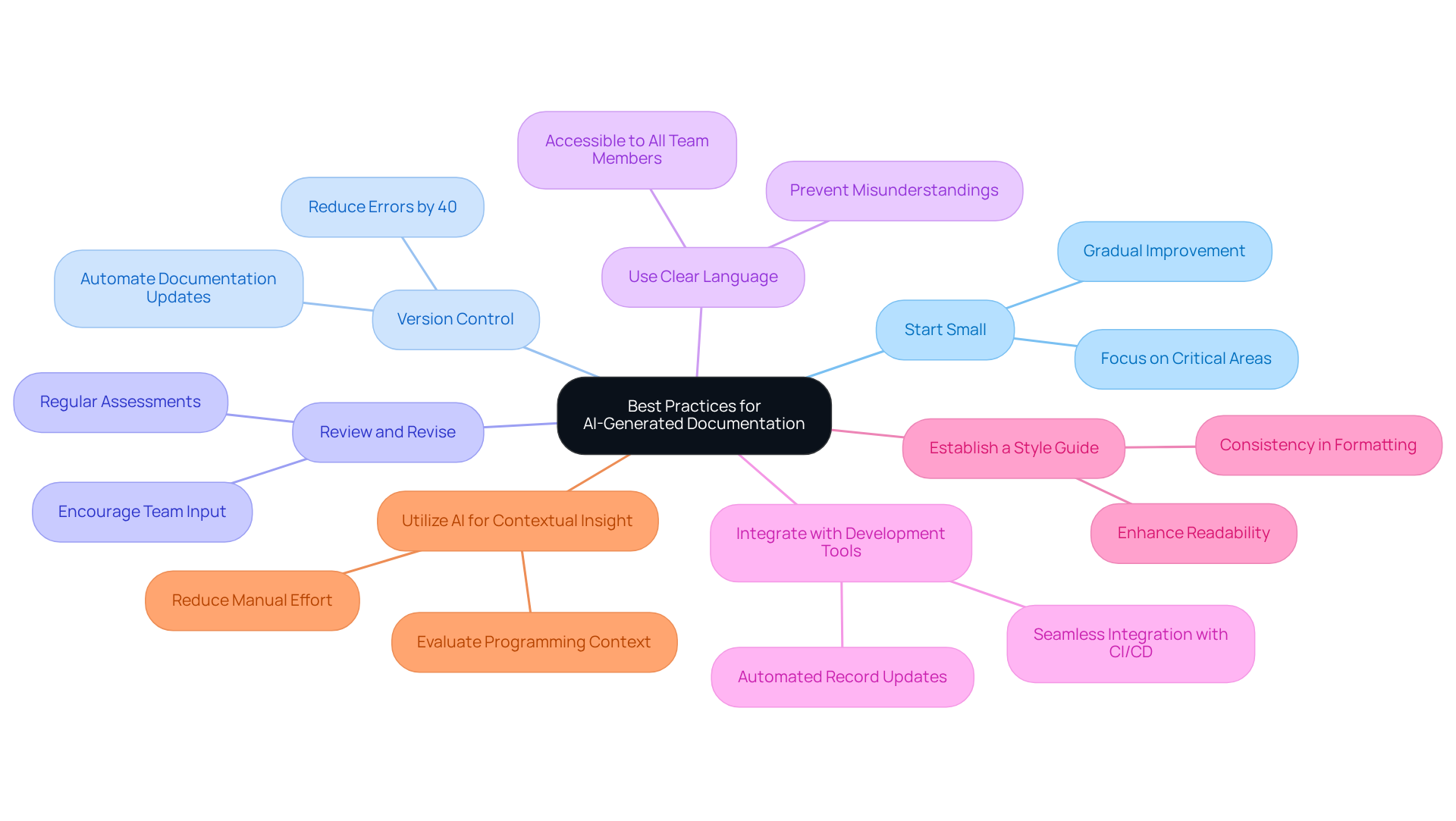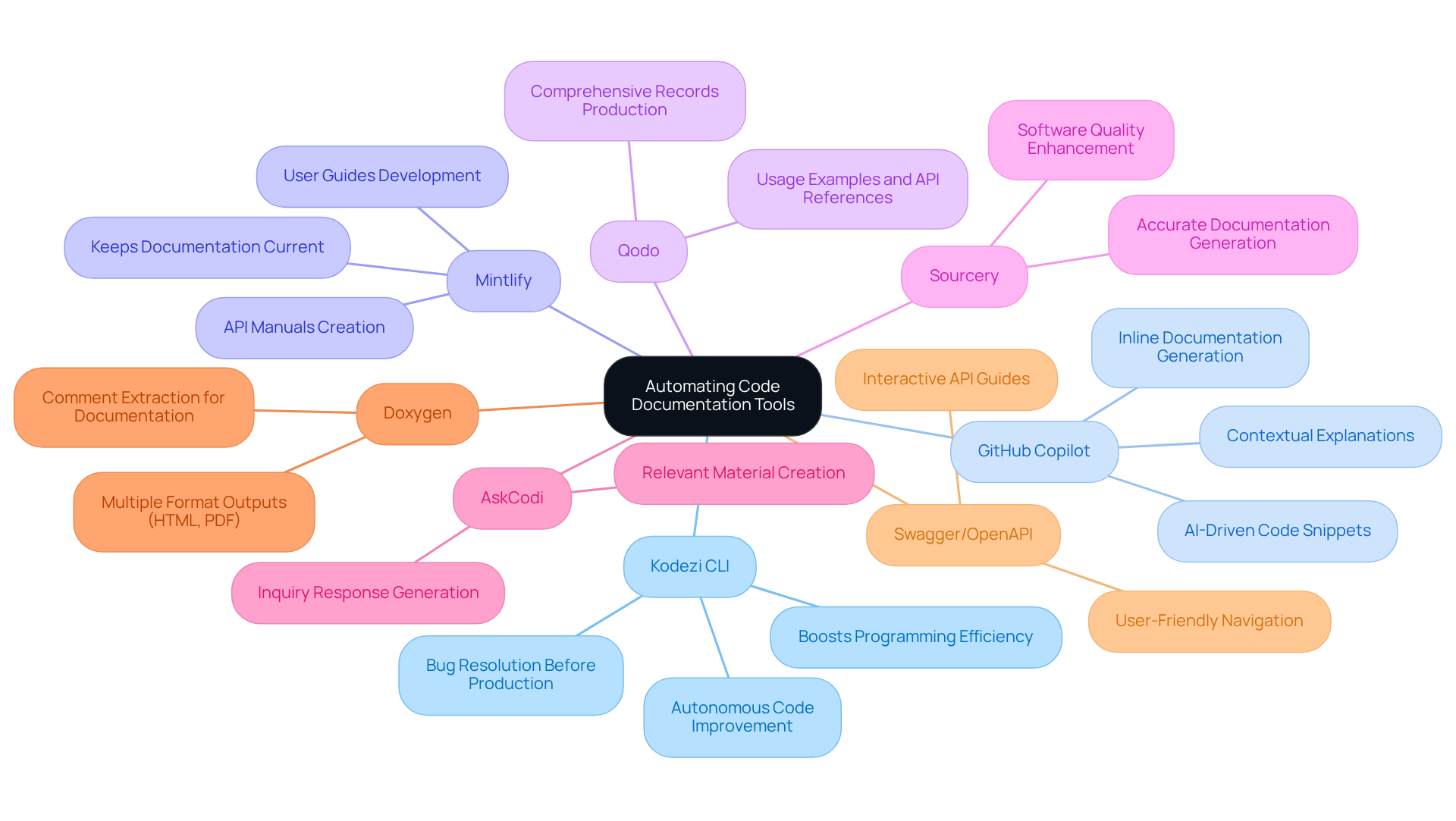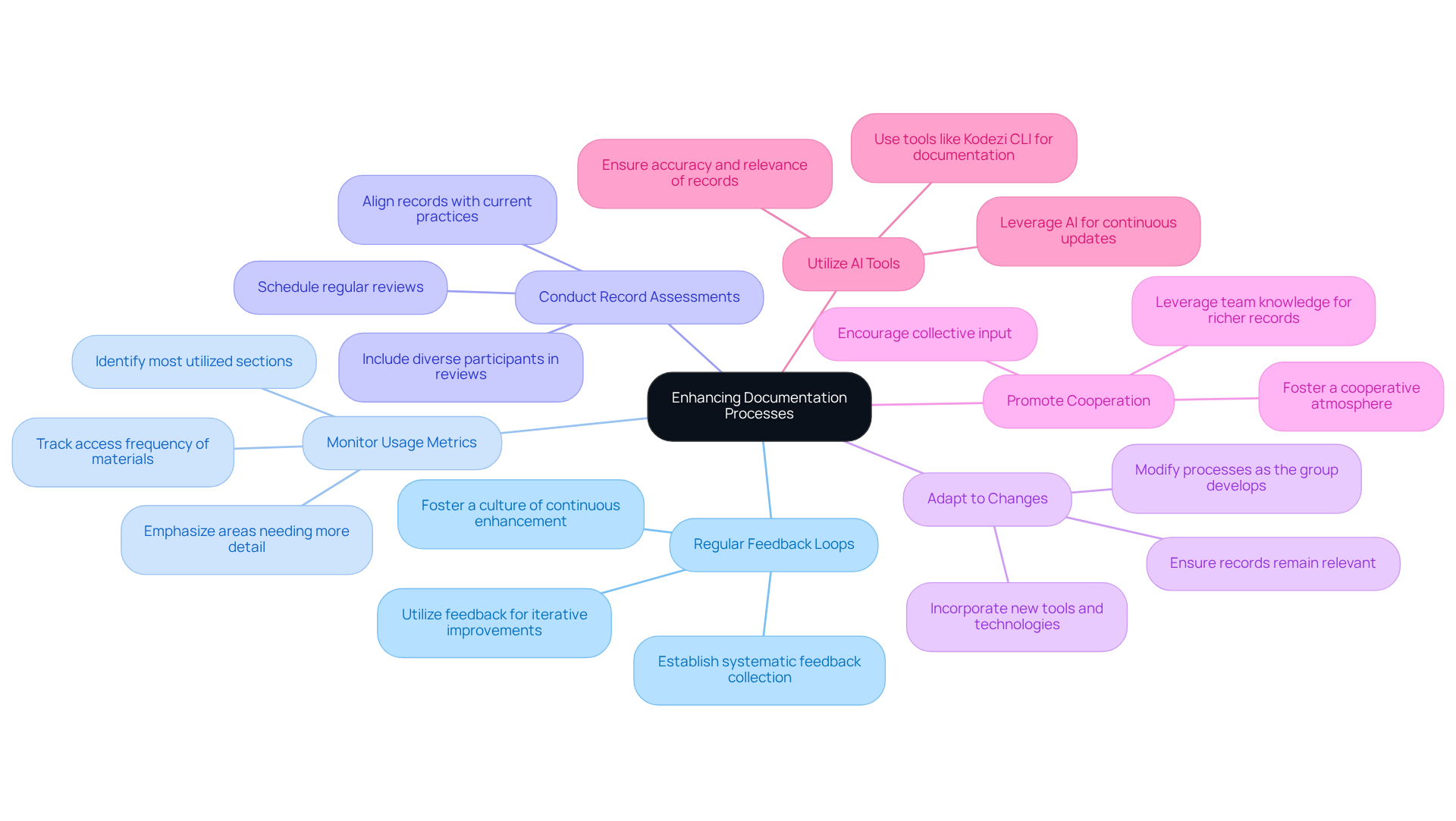Overview
Developers often encounter significant challenges in managing code documentation, which can hinder their efficiency and productivity. Kodezi addresses these coding challenges by automating the creation and management of documentation. This innovative tool not only reduces manual errors but also saves precious time for developers. Furthermore, using Kodezi enhances the accuracy and readability of documentation, allowing teams to maintain up-to-date records that facilitate better collaboration and integration of new developers.
Imagine the benefits of having a streamlined documentation process that boosts productivity. By leveraging Kodezi, teams can enjoy improved code quality and efficiency gains, ultimately leading to a more productive work environment. In addition, the platform's features ensure that documentation is always current, which is essential for effective teamwork.
Are you ready to enhance your coding practices? Explore the tools available on Kodezi today and experience the transformation in your software development process. With Kodezi, you can tackle documentation challenges head-on and focus on what truly matters—writing great code.
Introduction
In the realm of software development, the challenge of maintaining accurate and up-to-date documentation often overshadows the demands of coding itself. Furthermore, the advent of AI-driven documentation tools presents a transformative opportunity for developers seeking to enhance efficiency and collaboration. As teams grapple with the complexities of integrating new technologies, the question arises: how can embracing AI documentation practices streamline workflows and elevate code quality and team dynamics? This article delves into best practices and tools that empower developers to optimize their documentation processes, ensuring they keep pace with the rapid evolution of their codebases.
Understand AI Code Documentation and Its Importance
In the fast-paced world of software development, coding challenges can often hinder progress. AI project descriptions leverage artificial intelligence technologies to streamline the creation, management, and updating of materials for development initiatives. This innovative approach is essential in modern software engineering, as it automates traditionally time-consuming processes that are often prone to human error. How can teams benefit from this? The importance of AI code documentation lies in its capacity to enhance accuracy, improve readability, and ensure that the documentation evolves alongside the codebase.
By utilizing AI resources, teams can maintain thorough and current records—crucial for integrating new developers, enhancing collaboration, and reducing technical debt. Imagine significantly decreasing the time spent on manual tasks; this allows developers to focus on coding and innovation rather than administrative burdens. Furthermore, AI-generated records can drastically reduce the time devoted to these tasks. As a striking 81% of developers anticipate increased incorporation of AI tools in AI code documentation within the next year, the shift toward AI-driven reporting is not only advantageous but essential for boosting overall productivity and efficiency in software development.
In addition, embracing these AI tools can lead to remarkable improvements in code quality and team dynamics. Why wait? Explore the tools available on the platform to elevate your development process.

Implement Best Practices for AI-Generated Documentation
To effectively implement AI code documentation, developers often face significant challenges. However, by following best practices, these challenges can be addressed effectively:
- Start Small: Focus on documenting critical areas of your codebase first. This approach prevents overwhelming your group and allows for gradual improvement.
- Version Control: Treat documentation as a program. Utilizing version control systems is essential, as studies show that teams using version numbers experience up to 40% fewer errors. This ensures that updates are consistent with code changes and facilitates easier tracking of revisions.
- Review and Revise: Regularly assess AI-generated materials for accuracy and clarity. Motivate group members to offer input and implement required changes, nurturing a culture of collective responsibility in record-keeping.
- Use Clear Language: Ensure that the language used in written materials is clear and accessible to all team members, regardless of their technical expertise. This clarity is essential for prolonged project success, as inadequate records can result in misunderstandings and technical debt.
- Integrate with Development Tools: Utilize tools that integrate seamlessly with your existing development environment, such as GitHub or CI/CD pipelines. This integration enables automated record updates during code deployments, which enhances the AI code documentation and improves workflow efficiency.
- Establish a Style Guide: Create a style guide that outlines formatting, tone, and structure for written materials. Consistency in record-keeping enhances readability and professionalism, making it easier for team members to navigate.
- Utilize AI for contextual insight by employing AI code documentation that evaluates programming context and produces records that accurately represent the intent and functionality of the programming. This capability not only enhances clarity but also decreases the manual effort involved in record-keeping, enabling developers to concentrate on creating software.

Explore Tools for Automating Code Documentation
Developers often encounter significant challenges when it comes to efficiently creating AI code documentation. Fortunately, various instruments are available to streamline programming records, enhancing productivity and minimizing errors. Notably, Kodezi CLI stands out as a powerful resource tailored for B2B engineering teams, often referred to as the 'Swiss Army Knife' for engineers. It autonomously improves codebases and resolves bugs before they reach production, significantly boosting programming efficiency.
Furthermore, tools like GitHub Copilot offer AI-driven assistance by proposing programming snippets and generating written explanations based on the script's context. This capability simplifies the reporting process, allowing developers to focus on their core tasks. Similarly, Mintlify serves as an AI tool for crafting API manuals and user guides, ensuring they remain current with the latest programming updates.
In addition, Qodo examines codebases to produce comprehensive records, including usage examples and API references, which facilitate better understanding and usability. Sourcery focuses on enhancing software quality by automatically generating records that accurately reflect the system's current state, aiding in maintenance and clarity.
Have you considered how an AI assistant like AskCodi can help? It responds to inquiries about the program and generates relevant material, making the record creation process more engaging. Moreover, Doxygen is a widely-used generator that extracts comments from code to create documentation in various formats, including HTML and PDF, ensuring accessibility and ease of use.
For outlining RESTful APIs, Swagger/OpenAPI are crucial resources that enable developers to generate interactive API guides that are user-friendly and easy to navigate. Finally, Kodezi CLI not only improves codebases but also guarantees that documentation evolves alongside the software, effectively addressing typical challenges faced by engineering teams.
These tools not only enhance the recording process but also ensure that AI code documentation develops in tandem with the code, addressing the usual obstacles encountered by engineering groups. Explore the available tools on the platform to elevate your coding practices and improve productivity.

Iterate and Optimize Documentation Processes
To ensure your documentation processes remain effective, consider implementing the following iterative strategies:
-
Regular Feedback Loops: Establish a systematic approach for gathering feedback from team members on the clarity and usefulness of written materials. How often do you reflect on the feedback received? This feedback should be utilized to make iterative improvements, fostering a culture of continuous enhancement.
-
Monitor Usage Metrics: Track access frequency of materials and identify which sections are most utilized. Are your records meeting user needs effectively? This data can emphasize areas requiring more detail or clarity, ensuring that records fulfill user needs effectively.
-
Conduct Record Assessments: Schedule regular reviews to ensure records align with current coding practices and project requirements. Including participants from different roles can offer varied viewpoints. How diverse is your review process? This can enhance the review process.
-
Adapt to Changes: Remain adaptable and prepared to modify record-keeping processes as the group develops or as new tools and technologies are incorporated. This adaptability is crucial for preserving the significance of records.
-
Promote Cooperation: Foster a cooperative atmosphere where group members feel empowered to engage in record-keeping initiatives. What benefits can arise from collective input? This collective input can lead to richer, more comprehensive records that reflect the team's combined knowledge.
-
Utilize AI Code Documentation for Continuous Updates: Leverage AI tools like Kodezi CLI, which autonomously detects changes in the codebase and proposes modifications to AI code documentation. This guarantees that records develop alongside the code, preserving accuracy and relevance.
By implementing these strategies, teams can enhance their documentation processes and avoid common pitfalls, such as the unreliability of user feedback due to variability and subjectivity.

Conclusion
Embracing AI code documentation represents a transformative step for software development teams, enhancing both efficiency and accuracy. This innovative approach not only automates tedious record-keeping tasks but also ensures that documentation evolves in tandem with code, significantly reducing technical debt and improving collaboration among team members.
The article highlights several key strategies for implementing effective AI-generated documentation:
- Starting small
- Utilizing version control
- Fostering a culture of review and clarity
These essential practices can streamline the documentation process. Furthermore, leveraging powerful tools like Kodezi CLI, GitHub Copilot, and Swagger/OpenAPI can further enhance the quality and accessibility of documentation, making it a vital asset for any development team.
As the landscape of software development continues to evolve, integrating AI into documentation processes will be crucial for maintaining relevance and efficiency. Teams are encouraged to explore the available tools and best practices to optimize their documentation strategies. By doing so, they not only improve their immediate workflows but also set the stage for sustained innovation and success in the future.
Frequently Asked Questions
What is AI code documentation?
AI code documentation refers to the use of artificial intelligence technologies to streamline the creation, management, and updating of documentation materials for software development initiatives.
Why is AI code documentation important in software development?
It enhances accuracy, improves readability, and ensures that documentation evolves alongside the codebase, which is essential for modern software engineering.
How can teams benefit from using AI code documentation?
Teams can maintain thorough and current records, which is crucial for integrating new developers, enhancing collaboration, and reducing technical debt.
What impact does AI code documentation have on developers' time?
It significantly decreases the time spent on manual documentation tasks, allowing developers to focus more on coding and innovation.
What is the anticipated trend regarding AI tools in code documentation?
A striking 81% of developers expect increased incorporation of AI tools in AI code documentation within the next year, indicating a shift toward AI-driven reporting.
How does AI code documentation improve code quality and team dynamics?
Embracing AI tools can lead to remarkable improvements in code quality and enhance team dynamics by streamlining processes and reducing administrative burdens.




